| Listing 1 - 10 of 53 | << page >> |
Sort by
|
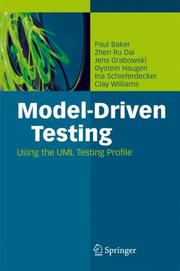
ISBN: 1281352837 9786611352837 3540725636 3540725628 9783540725626 Year: 2008 Publisher: Berliln ; New York : Springer,
Abstract | Keywords | Export | Availability | Bookmark
 Loading...
Loading...Choose an application
- Reference Manager
- EndNote
- RefWorks (Direct export to RefWorks)
Model-driven development has become the most important new paradigm in software development and has already demonstrated considerable impact in reducing time to market and improving product quality. However, the development of high-quality systems not only requires systematic development processes but also systematic test processes. This book is about systematic, model-driven test processes in the context of UML. As UML provides only limited means for the design and development of test artifacts, a consortium was formed by the Object Management Group (OMG) to develop a UML profile for model-driven testing – the UML Testing Profile (UTP), an official OMG standard since 2005. Written by the original members of this standardization group, this book shows you how to use UML to test complex software systems. The authors introduce UTP step-by-step, using a case study that illustrates how UTP can be used for test modeling and test specification. You’ll learn how UTP concepts can be used for functional and non-functional testing, with example applications and best practices for user-interfaces and service oriented architectures. In addition, the authors demonstrate how to apply UTP using frameworks like TTCN-3 and the JUnit test framework for Java. This book is the definitive reference for the only UML-based test specification language, written by the creators of that language. It is supported by an Internet site that provides information on the latest tools and uses of the profile.
Computer software --- UML (Computer science) --- Quality control. --- Testing. --- Software, Computer --- Computer systems --- Unified Modeling Language (Computer science) --- Modeling languages (Computer science) --- Object-oriented methods (Computer science) --- Development --- Information Technology --- Software Engineering
Periodical
ISSN: 19478194 Year: 2010 Publisher: Hershey, PA : IGI Publishing
Abstract | Keywords | Export | Availability | Bookmark
 Loading...
Loading...Choose an application
- Reference Manager
- EndNote
- RefWorks (Direct export to RefWorks)
Computer software --- UML (Computer science) --- Development --- Development. --- Computer Science --- Unified Modeling Language (Computer science) --- Modeling languages (Computer science) --- Object-oriented methods (Computer science) --- Development of computer software --- Software development
Book
ISBN: 9783031185564 Year: 2023 Publisher: Cham : Springer International Publishing : Imprint: Springer,
Abstract | Keywords | Export | Availability | Bookmark
 Loading...
Loading...Choose an application
- Reference Manager
- EndNote
- RefWorks (Direct export to RefWorks)
This book is about software product lines (SPLs) designed and developed taking UML diagrams as the primary basis, modeled according to a rigorous approach composed of an UML profile and a systematic process for variability management activities, forming the Stereotype-based Management of Variability (SMarty) approach. The book consists of five parts. Part I provides essential concepts on SPL in terms of the first development methodologies. It also introduces variability concepts and discusses SPL architectures finishing with the SMarty approach. Part II is focused on the design, verification and validation of SMarty SPLs, and Part III concentrates on the SPL architecture evolution based on ISO/IEC metrics, the SystEM-PLA method, optimization with the MOA4PLA method, and feature interaction prevention. Next, Part IV presents SMarty as a basis for SPL development, such as, the M-SPLearning SPL for mobile learning applications, the PLeTs SPL for testing tools, the PlugSPL plugin environment for supporting the SPL life cycle, the SyMPLES approach for designing embedded systems with SysML, the SMartySPEM approach for software process lines (SPrL), and re-engineering of class diagrams into an SPL. Eventually, Part V promotes controlled experimentation in UML-based SPLs, presenting essential concepts on how to plan, conduct, and document experiments, as well as showing several experiments carried out with SMarty. This book aims at lecturers, graduate students and experienced practitioners. Lecturers might use the book for graduate level courses about SPL fundamentals and tools; students will learn about the SPL engineering process, variability management, and mass customization; and practitioners will see how to plan the transition from single-product development to an SPL-based process, how to document inherent variability in a given domain, or how to apply controlled experiments to SPLs.
Computer software --- UML (Computer science) --- Reusability. --- Unified Modeling Language (Computer science) --- Modeling languages (Computer science) --- Object-oriented methods (Computer science) --- Reusability of software --- Reusable code (Computer programs) --- Software reusability --- Software reengineering --- Generic programming (Computer science) --- Development --- Software engineering. --- Software Engineering.
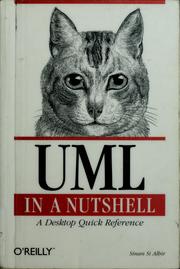
ISBN: 1565924487 9781565924482 Year: 1998 Publisher: Beijing O'Reilly
Abstract | Keywords | Export | Availability | Bookmark
 Loading...
Loading...Choose an application
- Reference Manager
- EndNote
- RefWorks (Direct export to RefWorks)
Programming --- UML (Computer science) --- Object-oriented methods (Computer science) --- UML (Informatique) --- Méthode orientée object (Informatique) --- Application software --- Development --- Méthode orientée object (Informatique) --- Unified Modeling Language (Computer science) --- Computer software --- Modeling languages (Computer science) --- Development of application software --- Application software - Development

ISBN: 0387215131 9786610187690 1280187697 1468492934 0387952098 Year: 2002 Publisher: New York : Springer-Verlag,
Abstract | Keywords | Export | Availability | Bookmark
 Loading...
Loading...Choose an application
- Reference Manager
- EndNote
- RefWorks (Direct export to RefWorks)
Guide to Successfully Applying the UML offers a tool-independent and process-independent roadmap for successfully applying the Unified Modeling Language (UML). The UML is a modeling language for specifying, visualizing, constructing, and documenting the artifacts of a system-intensive process. It was originally conceived by Rational Software Corporation and three of the most prominent methodologists in the information systems and technology industry: Grady Booch, James Rumbaugh, and Ivar Jacobson. The language has gained significant industry support from various organizations via the UML Partners Consortium and has been submitted to and approved by the Object Management Group as a standard. This book works in concordance with references to offer a suite of practical real-world examples to help novice and expert users of the UML to understand the whole language (holistically and cohesively), including rules of usage and principles of composition, style guidelines, and a roadmap for successfully applying the UML. The examples are presented in a "fairly intuitive/evolutionary" manner that demonstrate the key concepts of the UML and help readers explore the wide range of uses of the UML.
Application software --- UML (Computer science) --- Development. --- Programming --- programmeertalen --- UML (unified modeling language) --- Computer science. --- Computer programming. --- Software engineering. --- Computer Science. --- Software Engineering. --- Programming Techniques. --- Computers --- Electronic computer programming --- Electronic data processing --- Electronic digital computers --- Programming (Electronic computers) --- Coding theory --- Computer software engineering --- Engineering --- Unified Modeling Language (Computer science) --- Computer software --- Modeling languages (Computer science) --- Object-oriented methods (Computer science) --- Development of application software --- Development
Book
ISBN: 0262660180 Year: 1973 Publisher: Cambridge (Mass.): MIT press
Abstract | Keywords | Export | Availability | Bookmark
 Loading...
Loading...Choose an application
- Reference Manager
- EndNote
- RefWorks (Direct export to RefWorks)
DYNAMO (Computer program language) --- 681.3*I6 --- Dynamic models (Computer program language) --- Industrial management --- Modeling languages (Computer science) --- Programming languages (Electronic computers) --- Simulation and modeling (Computing methodologies)--See also {681.3*G3} --- Mathematical models --- 681.3*I6 Simulation and modeling (Computing methodologies)--See also {681.3*G3}
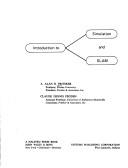
ISBN: 0470265884 9780470265888 Year: 1979 Publisher: New York Wiley
Abstract | Keywords | Export | Availability | Bookmark
 Loading...
Loading...Choose an application
- Reference Manager
- EndNote
- RefWorks (Direct export to RefWorks)
Digital computer simulation --- SLAM (Computer program language) --- Simulation par ordinateur --- Digital computer simulation. --- Digital simulation --- Computer simulation --- Simulation Language for Alternative Modeling (Computer program language) --- FORTRAN (Computer program language) --- Modeling languages (Computer science) --- Simulations --- Applications of computer systems --- Programming languages: SLAM language --- SLAM (Computer program language).
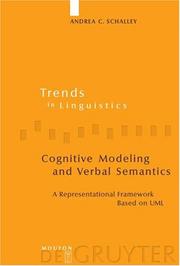
ISBN: 3110179512 3110909626 Year: 2004 Volume: 154 Publisher: Berlin : Mouton de Gruyter,
Abstract | Keywords | Export | Availability | Bookmark
 Loading...
Loading...Choose an application
- Reference Manager
- EndNote
- RefWorks (Direct export to RefWorks)
This book presents a unique approach to the semantics of verbs. It develops and specifies a decompositional representation framework for verbal semantics that is based on the Unified Modeling Language (UML), the graphical lingua franca for the design and modeling of object-oriented systems in computer science. The new framework combines formal precision with conceptual flexibility and allows the representation of very complicated details of verbal meaning, using a mixture of graphical elements as well as linearized constructs. Thereby, it offers a solution for different semantic problems such as context-dependency and polysemy. The latter, for instance, is demonstrated in one of the two well-elaborated applications of the framework within this book, the investigation of the polysemy of German setzen. Besides the formal specification of the framework, the book comprises a cognitive interpretation of important modeling elements, discusses general issues connected with the framework such as dynamic and static aspects of verbal meanings, questions of granularity, and general constraints applying to verbal semantics. Moreover, first steps towards a compositional semantics are undertaken, and a new verb classification based on this graphical approach is proposed. Since the framework is graphical in nature, the book contains many annotated figures, and the framework's modeling elements are illustrated by example diagrams. Not only scholars working in the field of linguistics, in particular in semantics, will find this book illuminating because of its new graphical approach, but also researchers of cognitive science, computational linguistics and computer science in general will surely appreciate it.
Semantics --- Mathematical models --- UML (Computer science) --- Programming languages (Electronic computers) --- Cognitive grammar --- Lexicology. Semantics --- Psycholinguistics --- Cognitive grammar. --- Sémantique --- UML (Informatique) --- Langages de programmation --- Grammaire cognitive --- Modèles mathématiques --- #KVHA:Semantiek --- Cognitive linguistics --- Grammar, Comparative and general --- Programming language semantics --- Unified Modeling Language (Computer science) --- Computer software --- Modeling languages (Computer science) --- Object-oriented methods (Computer science) --- Mathematical linguistics --- Mathematical models. --- Semantics. --- Development
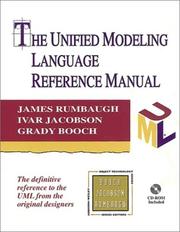
ISBN: 020130998X 9780201309980 Year: 1999 Publisher: London ; Amsterdam ; Sydney, N.S.W [etc.] : Addison-Wesley,
Abstract | Keywords | Export | Availability | Bookmark
 Loading...
Loading...Choose an application
- Reference Manager
- EndNote
- RefWorks (Direct export to RefWorks)
Computer. Automation --- Computer software --- UML (Computer science) --- Logiciels --- UML (Informatique) --- Development --- Développement --- Development. --- -infobib --- 681.3*D21 --- Unified Modeling Language (Computer science) --- Modeling languages (Computer science) --- Object-oriented methods (Computer science) --- Software, Computer --- Computer systems --- Requirements/specifications: languages; methodologies; tools (Software engineering)--See also {681.3*D31} --- UML (Computer science). --- 681.3*D21 Requirements/specifications: languages; methodologies; tools (Software engineering)--See also {681.3*D31} --- Développement --- infobib --- Development of computer software --- Software development --- Computer software - Development.
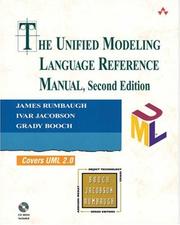
ISBN: 0321245628 9780321245625 Year: 2005 Publisher: Boston Addison-Wesley
Abstract | Keywords | Export | Availability | Bookmark
 Loading...
Loading...Choose an application
- Reference Manager
- EndNote
- RefWorks (Direct export to RefWorks)
UML (unified modeling language) --- Computer. Automation --- Computer software --- UML (Computer science) --- Logiciels --- UML (Informatique) --- Development --- Développement --- 681.3*D21 --- Requirements/specifications: languages; methodologies; tools (Software engineering)--See also {681.3*D31} --- Contains audio-visual material --- 681.3*D21 Requirements/specifications: languages; methodologies; tools (Software engineering)--See also {681.3*D31} --- Développement --- Unified Modeling Language (Computer science) --- Modeling languages (Computer science) --- Object-oriented methods (Computer science) --- Development of computer software --- Software development --- Computer software - Development
| Listing 1 - 10 of 53 | << page >> |
Sort by
|

 Search
Search Feedback
Feedback About
About Help
Help News
News